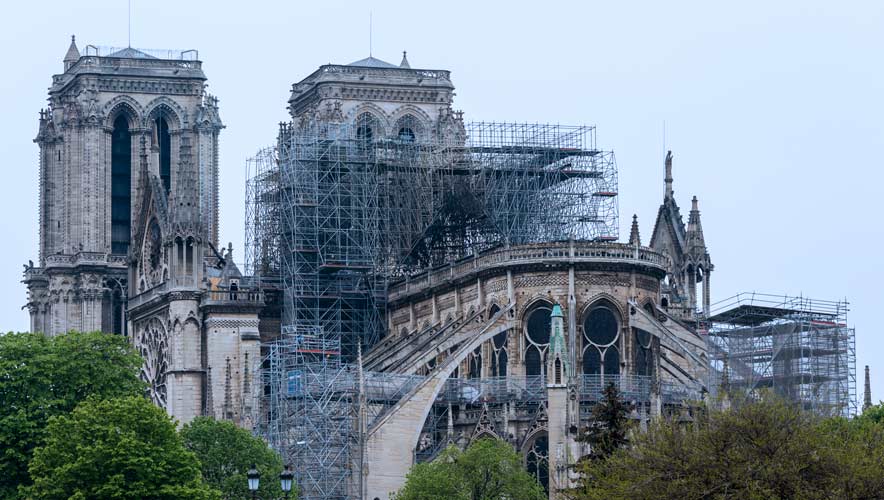Restoring Resilience: The Notre Dame Cathedral Recovery
It was a calm evening in Paris. People were beginning their commutes home and work on the $135 million restoration project at Notre Dame Cathedral had paused for the day when at 6:20 p.m. the unimaginable happened: a fire broke out in the cathedral’s attic.
The 15 April 2019 fire smoldered in the dusty space and set off a fire alarm. But after a physical check, no one spotted flames and no further action was taken. But the blaze continued, spreading throughout the attic and catching on the cathedral’s timber trusses before moving across the roof and engulfing the 300-foot spire—ultimately causing its collapse.
Twenty-three minutes after the first fire alarm went off, a second alarm went off. This time, security personnel sprang into action. The fire department was notified, and firefighters were dispatched to attempt to put out the blaze without causing additional damage to the cathedral.
“Following a protocol developed for just such a disaster, firefighters knew which works of art to rescue and in which order,” according to Science magazine. “They knew to keep the water pressure low and to avoid spraying stained glass windows so the cold water wouldn’t shatter the hot glass.”
They successfully put out the blaze. But the damage was considerable. The iconic spire was gone. The roof had collapsed. And 400 tons of lead—a critical structural element in the cathedral’s construction—had melted, coating the remains of the facility in its toxic residue.
Emergency Recovery Measures
After the fire the restoration project had to take some immediate, emergency measures to prevent further deterioration of the scene, said Francesco Bandarin, an architect and urban planner, in a presentation at the National Conference on Cultural Property Protection in October 2022.
The restoration team built giant, wooden supports to hold up the walls that normally relied on the support of the cathedral’s flying buttresses and roof to remain upright. The supports meant that the cathedral’s walls were no longer vulnerable to winds that could blow them over, explained Bandarin, who is the former director of the UNESCO World Heritage Centre and assistant director-general of UNESCO for Culture.
Following a protocol developed for just such a disaster, firefighters knew which works of art to rescue and in which order.
The team also deployed robots to clear debris from the interior of the cathedral because it was unsafe for humans to enter the area. Additionally, the team worked with investigators to remove the melted lead and ensure that individuals outside of the cathedral site were not exposed to lead in the process, Bandarin added.
One of the more complicated restoration projects involved dismantling the scaffolding that was around the cathedral’s spire at the time of the fire. The scaffolding survived the blaze, but it was warped and damaged.
“When the flames were extinguished, the 40,000-piece web of tangled, melted metal weighing 200 tons—half of which were over 300 feet high—dangled precariously, posing a serious threat to the cathedral,” according to Friends of Notre Dame, the official charity funding the restoration team. The scaffolding remained in this position until 8 June 2020 when monitors were placed on the structure to measure any shifts in the scaffolding that might signal a collapse. If that level of shift was detected, an alarm sounded and everyone inside the cathedral on the ground was required to exit. The restoration team then built a secondary metal structure around the scaffolding to support it, and new scaffolding was installed. Workers then began removing the original scaffolding by hand.
“Specially trained rope access technicians rappelled into the structure as close as they could, to cut away the charred parts and molten metal tubes away from each other,” according to the restoration team. “The pieces removed were collected in a basket suspended between them. This meticulous and labor-intensive process was completed in mid-August.”
Building Resilience
Notre Dame was built in the 12th century and has undergone restoration efforts throughout its history, but none of these efforts included installing fire breaks or sprinkler systems in the cathedral. This meant that when the April 2019 fire broke out, there were not measures in place to effectively stop its spread without human intervention.
The current restoration effort will include measures to address that, however, and make the cathedral more resilient in the face of future fires. The restoration team approved a plan to install firewalls and a sprinkler system that uses mist to minimize water damage from deployment. The new attic will also have fire fighting equipment in place, so first responders do not have to worry about hauling equipment into the cathedral, Bandarin said.
“We have to put modern technology to work for rapid response and to answer these situations,” he added. “I’m not a firefighter, but this is basic.”
Meanwhile, restoration of the cathedral’s art, organ, and other structural components continues with the goal to have it open to the public by 2024—in time for Paris to host the Olympics.
“We’re all quite confident that 2024 will be the year of completing a large part of this reconstruction site and the reopening of the cathedral to worshippers and the public, although there’ll be more work to do after 2024, of course,” said French Culture Minister Rima Abdul-Malak after visiting Notre Dame earlier this year.
For more on the Notre Dame Cathedral fire and fire prevention at cultural properties, check out these pieces from our archives “Lessons Learned from the Notre Dame Fire” and “A Portrait of Fire Prevention.”
Megan Gates is editor-in-chief of Security Technology. Connect with her at [email protected] or on LinkedIn. Follow her on Twitter: @mgngates.











